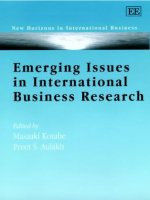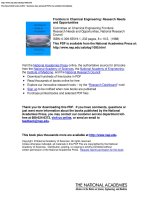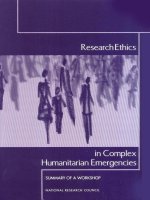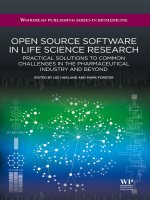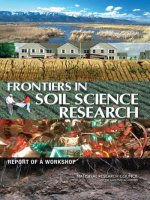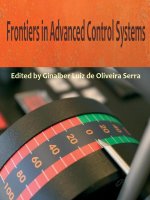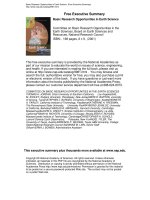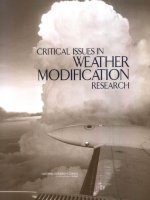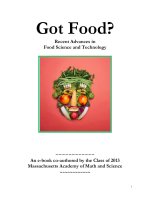FRONTIERS IN SOIL SCIENCE RESEARCH doc
Bạn đang xem bản rút gọn của tài liệu. Xem và tải ngay bản đầy đủ của tài liệu tại đây (733.6 KB, 81 trang )
REPORT OF A WORKSHOP
FRONTIERS IN
SOIL SCIENCE
RESEARCH
Steering Committee for Frontiers in Soil Science Research
Board on International Scientific Organizations
Policy and Global Affairs
THE NATIONAL ACADEMIES PRESS 500 Fifth Street, N.W. Washington, DC 20001
NOTICE: The project that is the subject of this report was approved by the Governing
Board of the National Research Council, whose members are drawn from the councils
of the National Academy of Sciences, the National Academy of Engineering, and the
Institute of Medicine. The members of the committee responsible for the report were
chosen for their special competences and with regard for appropriate balance.
Support for this workshop was provided by the National Science Foundation under
Grant No. 0506228; the U.S. Department of Agriculture, Agricultural Research Service
under Agreement No. 59-0790-5-085; the Department of Energy under Grant No. DE-
FG02-05ER64014; and the Soil Science Society of America. Any opinions, findings,
conclusions, or recommendations expressed in this publication are those of the author(s)
and do not necessarily reflect the views of the organizations or agencies that provided
support for the project.
International Standard Book Number-13: 978-0-309-13891-8
International Standard Book Number-10: 0-309-13891-4
Cover: Design by Francesca Moghari. Photo credits, from top to bottom: first by Ron
Nichols and second and third by Lynn Betts, courtesy of the USDA Natural Resources
Conservation Service; fourth, courtesy of SLAC Stanford Synchrotron Radiation Light-
source (SSRL); and fifth, courtesy of PhotoDisc.
Additional copies of this report are available from the National Academies Press, 500
Fifth Street, N.W., Lockbox 285, Washington, DC 20055; (800) 624-6242 or (202)
334-3313 (in the Washington metropolitan area); Internet, .
Copyright 2009 by the National Academy of Sciences. All rights reserved.
Printed in the United States of America
The National Academy of Sciences is a private, nonprofit, self-perpetuating society of
distinguished scholars engaged in scientific and engineering research, dedicated to the
furtherance of science and technology and to their use for the general welfare. Upon the
authority of the charter granted to it by the Congress in 1863, the Academy has a man-
date that requires it to advise the federal government on scientific and technical matters.
Dr. Ralph J. Cicerone is president of the National Academy of Sciences.
The National Academy of Engineering was established in 1964, under the charter of
the National Academy of Sciences, as a parallel organization of outstanding engineers.
It is autonomous in its administration and in the selection of its members, sharing with
the National Academy of Sciences the responsibility for advising the federal government.
The National Academy of Engineering also sponsors engineering programs aimed at
meeting national needs, encourages education and research, and recognizes the superior
achievements of engineers. Dr. Charles M. Vest is president of the National Academy
of Engineering.
The Institute of Medicine was established in 1970 by the National Academy of Sciences
to secure the services of eminent members of appropriate professions in the examination
of policy matters pertaining to the health of the public. The Institute acts under the
responsibility given to the National Academy of Sciences by its congressional charter to
be an adviser to the federal government and, upon its own initiative, to identify issues
of medical care, research, and education. Dr. Harvey V. Fineberg is president of the
Institute of Medicine.
The National Research Council was organized by the National Academy of Sciences in
1916 to associate the broad community of science and technology with the Academy’s
purposes of furthering knowledge and advising the federal government. Functioning in
accordance with general policies determined by the Academy, the Council has become
the principal operating agency of both the National Academy of Sciences and the Na-
tional Academy of Engineering in providing services to the government, the public, and
the scientific and engineering communities. The Council is administered jointly by both
Academies and the Institute of Medicine. Dr. Ralph J. Cicerone and Dr. Charles M. Vest
are chair and vice chair, respectively, of the National Research Council.
www.national-academies.org
v
STEERING COMMITTEE FOR
FRONTIERS IN SOIL SCIENCE RESEARCH
CHARLES W. RICE, Chair, Kansas State University, Manhattan, Kansas
PAUL M. BERTSCH, University of Kentucky, Lexington, Kentucky
JOHAN BOUMA, Wageningen University [Retired], Rhenen,
Netherlands
JENNIFER HARDEN, U.S. Geological Survey, Menlo Park, California
JERRY L. HATFIELD, U.S. Department of Agriculture–Agricultural
Research Service, Ames, Iowa
JULIE D. JASTROW, Argonne National Laboratory, Argonne, Illinois
WILLIAM A. JURY, University of California, Riverside, California
JOAQUIN RUIZ, University of Arizona, Tucson, Arizona
NRC Staff
LOIS E. PETERSON, Senior Program Officer
P. KOFI KPIKPITSE, Program Associate
MARIZA SILVA, Program Associate (until February 2006)
vii
Preface and Acknowledgments
A
s stated in Science, “Soils are the most complicated biomaterials on
the planet” (Young and Crawford, 2004
1
). Soils provide support for
both natural and human systems. A challenge for soil science is the need
for interdisciplinary research involving classical soil science subdisciplines,
namely, soil chemistry, soil physics, soil biology, soil mineralogy, and pe-
dology. While basic research provides an understanding of fundamental
soil processes, increasing trends in land transformations, environmental
challenges, and policy issues require interdisciplinary approaches. To suc-
cessfully address major research needs, soil scientists must collaborate with
each other and with scientists in related disciplines.
In December 2005 the National Academies convened a workshop,
Frontiers in Soil Science Research, of experts in soil science and associated
disciplines to identify emerging research opportunities and expected ad-
vances in soil science, particularly in the integration of biological, geologi-
cal, chemical, and information technology sciences. The three objectives of
the workshop were to
1. identify research priorities and potential breakthroughs within
soil science;
2. identify interdisciplinary and cross-disciplinary research opportu-
1
Young, I. M., and Crawford, J.W. 2004. Interactions and self-organisation in the soil-
microbe complex. Science 304:1634-1637.
viii PREFACE AND ACKNOWLEDGMENTS
nities in which soil science is involved, particularly in the field of biogeosci-
ence; and
3. identify technological and computational needs to advance soil
science.
More than 120 people attended the workshop, with attendees from all
around the United States as well as from countries such as New Zealand, the
Netherlands, Canada, Italy, Philippines, Germany, and the United King-
dom. The attendees came from several fields, including not only academia
but also government and industry. The workshop agenda is included as Ap-
pendix A of this report. Funding for this workshop came from the National
Science Foundation, the Department of Energy, the U.S. Department of
Agriculture–Agricultural Research Service, and the Soil Science Society of
America.
The committee would like to thank the speakers and discussants who
gave enlightening presentations and comments, providing a basis for the
plenary discussions and breakout groups held during the workshop. The
speakers and discussants are listed in Appendix B of this report.
One of the exciting aspects of the workshop was the inclusion of a select
few graduate students, who not only served as rapporteurs of the breakout
sessions but also presented posters of their own research on the second
evening of the workshop. Those graduate students, with their affiliations at
the time of the workshop, were as follows:
Amy Brock, University of Nevada, Las Vegas
Daniel Clune, Cornell University
Josh Heitman, Iowa State University
DeAnn Ricks Presley, Kansas State University
Matt Ruark, Purdue University
As chair, I would also like to thank the members of the workshop steer-
ing committee (listed in Appendix C) and the National Research Council
staff who organized the workshop and assisted with the writing of this
summary: P. Kofi Kpikpitse, Lois Peterson, and Mariza Silva. We would
also like to express thanks to Ester Sztein for her assistance in the comple-
tion of this report.
This report has been reviewed in draft form by individuals chosen for
their diverse perspectives and technical expertise, in accordance with pro-
cedures approved by the National Academies’ Report Review Committee.
PREFACE AND ACKNOWLEDGMENTS ix
The purpose of this independent review is to provide candid and critical
comments that will assist the institution in making its published report as
sound as possible and to ensure that the report meets institutional standards
for quality and objectivity. The review comments and draft manuscript
remain confidential to protect the integrity of the process.
We wish to thank the following individuals for their review of this
report: Sally Brown, University of Washington; Martin Carter, Agriculture
and Agri-Food Canada; Oliver Chadwick, University of California, Santa
Barbara; Jon Chorover, University of Arizona; Brent Clothier, Horticultural
and Food Research Institute, New Zealand; and Wayne Hudnall, Texas
Tech University.
Although the reviewers listed above have provided many constructive
comments and suggestions, they were not asked to endorse the content of
the report, nor did they see the final draft before its release. Responsibility
for the final content of this report rests entirely with the authors and the
institution.
Charles W. Rice
Chair, Steering Committee for
Frontiers in Soil Science Research
xi
Contents
1 Introduction 1
2 Placing a Value on Soil Science Research 8
3 Summary of Presentations 13
Session 1: Using Tracers to Understand Soil Processes, 13
Session 2: Using Microscopic and Spectroscopic Techniques to
Elucidate Chemical Processes, 16
Session 3: Nature’s Greatest Biological Frontier—the Soil
Community, 18
Session 4: Effect of In Situ Soil Architecture on Soil Physical,
Chemical, and Biological Processes, 21
Summary of the First Day’s Discussion, 22
Session 5: Upscaling to a Regional Level, 23
Session 6: New Tools for In Situ and Laboratory Measurements, 25
Session 7: Key Indicators for Detecting the Resilience and Stability of
the Soil System, 26
4 The Frontiers in Soil Science Research 31
Overarching Challenges, 31
Research Needs and Opportunities, 33
Tools, Techniques, and Current Opportunities, 38
xii CONTENTS
Interdisciplinary Collaborations and Emerging Research
Opportunities, 40
Student and Training Issues, 43
Epilogue 45
Appendixes
A Workshop Agenda 49
B Speakers and Discussants 54
C Steering Committee Members 66
1
1
Introduction
S
oil is a biogeochemically dynamic natural resource that supports all
critical components that comprise terrestrial ecosystems. It has been
called Earth’s living skin. On its June 11, 2004, cover, Science declared soils
to be “the final frontier.” The growing awareness that soil provides a variety
of ecosystem services beyond food production has attracted interest in soil
from nonsoil scientists. Collectively, soil is known as the pedosphere, and
the processes occurring within soil are inextricably linked to ecosystem
services such as water quantity and quality, are important in the exchange
of atmospheric gases, and are central to the biogeochemical cycles of the
nutrients and carbon that sustain life (see Figure 1-1). Soil supports the
richest biodiversity on Earth and functions as a filter for, and a buffer of,
inorganic and organic contaminants as well as pathogenic microorganisms
and viruses. Despite the link between the quality of the soil resource and the
rise and fall of world civilizations that has been repeated throughout history,
soil remains an undervalued and underappreciated resource.
There has been renewed interest in soil and soil science in recent years
as the recognition that biogeochemical processes that occur at the Earth’s
surface influence global climate change, land degradation and remedia-
tion, the fate and transport of nutrients and contaminants, soil and water
conservation, soil and water quality, food sufficiency and safety, global
carrying capacity, wetlands function, and many other issues pertinent to
the stewardship and conservation of land and water resources (special issue
of Science
, 2004). Population pressure and associated changes in land use pressure and associated changes in land use
2 FRONTIERS IN SOIL SCIENCE RESEARCH
place an increasingly high burden on the global soil resource. In some areas
of the Earth we have approached irreversible soil conditions that threaten
the existence of future generations. Understanding the long-term implica-
tions of decreased soil quality and addressing the aforementioned challenges
will require new information based on advances and breakthroughs in soil
science research that need to be effectively communicated to stakeholders,
policy makers, and the general public.
Soil science is an intrinsically interdisciplinary science that inte-
grates knowledge of physical, chemical, and biological processes thatphysical, chemical, and biological processes that
interact across a large range of spatial and temporal scales. Soil scientists
employ a multiscale approach—from the molecular to the landscape
levels—to address issues related to biogeochemical reactions and pro-
cesses in the environment, land use and degradation, regional and global
climate change, food security, and water quality. There have been several
National Research Council studies that identify areas in which opportu-
nities for basic research in soil science are especially compelling. A report
on the bioavailability of contaminants in soils and sediments noted the
need for further research on how physical, chemical, and biological
FIGURE 1-1 Interactive processes linking pedosphere with atmosphere, biosphere,
hydrosphere, and lithosphere.
SOURCE: Lal, Kimble, and Follett, 1997, 4. Reproduced with permission of Taylor &
Francis Group LLC.
p
h
o
t
o
s
y
n
t
h
e
s
i
s
e
v
a
p
o
r
a
t
i
o
n
r
e
s
p
i
r
a
t
i
o
n
p
r
e
c
i
p
i
t
a
t
i
o
n
e
l
e
m
e
n
t
a
l
u
p
t
a
k
e
g
r
o
u
n
d
w
a
t
e
r
r
e
c
h
a
r
g
e
r
o
c
k
w
e
a
t
h
e
r
i
n
g
r
u
n
o
f
f
&
s
e
e
p
a
g
e
elemental
cycling
soil flora
& fauna
evaporation
soil
water
soil
formation
leaching
energy
exchange
gaseous
emissions
Biosphere
Lithosphere
Pedosphere
Atmosphere
Hydrosphere
Figure 1
completely redrawn
based on Lal Rattan’s original
broadside (landscape)
vector, editable
INTRODUCTION 3
processes in soil influence the bioavailability of chemicals (National Re-
search Council, 2003). The report also noted the uncertainty related to
variations in soil at various spatial scales, something that was discussed
at this workshop. A Board on Agriculture report described the inherent
link between soil and water quality, noting that soil productivity is not
the only reason to protect soil resources (National Research Council,
1993). This report stated the need for research leading to the develop-
ment of new technologies that protect soil and water quality. A report on
metagenomics noted that this new science will draw on expertise from
several disciplines, including soil science (National Research Council,
2007).
Another report discussed the integrative studies of the “Critical
Zone,” which encompasses the soil, rock, air, water, and ice at the Earth’s
surface (National Research Council, 2001). The soil, or pedosphere, is
the interface among the other components of the Critical Zone—the bio-
sphere, hydrosphere, atmosphere, cryosphere, and lithosphere. As such,
it is a major determinant of the global water, carbon, and geochemical
cycles. Since soil represents a natural body covering essentially the entire
nonaqueous surface of planet Earth, it is intimately involved in absorp-
tion, storage, transfer, and release of heat, water, gases, and chemical
constituents; serves as a reservoir for biological and microbial diversity;
and, as such, has a profound influence on all living organisms.
A report emanating from a National Science Foundation-sponsored
workshop on the Critical Zone (Brantley et al., 2006) reiterated the im-
portance of applying fundamental knowledge of soils to understanding
the complex coupled hydrobiogeochemical processes occurring in the
Critical Zone. Because of the central role of the pedosphere, it is clear
that progress in understanding key processes in the Critical Zone is
predicated on breakthroughs in soil science research. An understanding
of critical soil processes and the ability to measure them is also central
to other emerging research initiatives, such as the National Ecological
Observatory Network. Soil science is at a critical threshold in identify-
ing new areas for research. Emerging topics—such as climate change,
carbon sequestration, water quality, vadose zone transport of nutrients
and contaminants, biofuels, and food security—need strategic research
on soil processes. New and emerging technologies and sensors are pro-
viding unprecedented opportunities for revolutionary advances and
breakthroughs in fundamental soil science research. These opportunities
enhance problem-solving abilities and integrate knowledge from associ-
4 FRONTIERS IN SOIL SCIENCE RESEARCH
ated disciplines (i.e., microbiology, hydrology, ecology, environmental
science, geochemistry, geology, atmospheric sciences) to further unravel
the mystery of soils and soil processes. As was noted in Science, “Inter-
est in soil is booming, spurred in part by technical advances of the past
decade” (Sugden, Stone, and Ash, 2004, 1613).
On December 12-14, 2005, the National Academies convened the
Frontiers in Soil Science Research Workshop to identify emerging areas
for research in soil science by addressing the interaction of soil science
subdisciplines, collaborative research with other disciplines, and the use of
new technologies in research. The organizing committee for the workshop
identified seven key questions that addressed research frontiers for the in-
dividual soil science disciplines, but also addressed the need for integration
across soil science and with other disciplines.
The seven questions addressed by the speakers and discussants were
as follows:
1. How well do we understand the physical, chemical, and bio-
logical processes in soils that impact the atmosphere, vegetation, and the
hydrogeosphere?
2. What are the chemical interactions at the molecular level that define
the fate of ions, chemicals, and microbes as they are transported through
soil systems?
3. What controls biodiversity belowground? How does this biodiver-
sity affect the function of the soil system?
4. What is the effect of in situ soil architecture on soil physical,
chemical, and biological processes? How does it vary from one soil system
to another? What are the controlling factors?
5. How does landscape architecture (topography, vegetation, land use)
affect the upscaling of soil processes to a regional level?
6. What are the new tools for making in situ and laboratory measure-
ments of soil biological and physicochemical properties and processes?
7. From a systems analysis standpoint, what are the key indicators for
detecting the resilience and stability of the soil system? What are the critical
factors that control its resilience and stability?
The committee then proceeded to identify potential speakers and dis-
cussants for each of these seven questions, which addressed chemical, bio-
logical, and physical processes, and their interactions. In choosing speakers
and discussants, the committee looked for individuals who would be able
INTRODUCTION 5
to address the questions from both a disciplinary and an interdisciplinary
viewpoint. A particular strength of the workshop, as described by many
attendees, was that the presentations cut across and integrated traditional
subdisciplinary areas of soil science. The organizing committee purposely
selected speakers for their abilities to cut across these lines and examine
coupled hydrobiogeochemical processes. The workshop was not designed
to identify specific issues within a subdiscipline.
As part of the overall goal of the workshop to identify frontiers in
soil science research, speakers, discussants, and attendees (the workshop
was open to all interested individuals) were asked to consider overarching
issues:
• Main challenges and priorities within basic soil science research
• Opportunities for inter- and cross-disciplinary research
• Technological and computational opportunities to advance soil
science research
• Student and early career training issues
At first glance, it may appear that the workshop did not explore par-
ticularly “new frontiers” in soil science research. However, several attendees
at the workshop commented that they were learning new ways to approach
their own research. In many cases, the “frontier” may not be a specific tech-
nology or technique new to the field, but expanded use of existing technolo-
gies (i.e., tracers, spectroscopy, “omics”) within the soil science community.
Many readers may find a new approach or technique with which they are
not familiar or which they have yet to explore themselves.
Although the original intent had been to also address the role of federal
funding for research in soil science, the committee decided to not specifi-
cally address funding issues to avoid discussion that would devolve into a
plea for more funding from sponsors present at the workshop. However,
there were discussions during the workshop that identified a lack of an ef-
fective primary sponsor or steward of the soil science discipline and how
this is problematic for maintaining strength in the discipline that could
be leveraged in the interdisciplinary activities and opportunities in other
funding agencies. To many people, including many in the federal funding
agencies, soil science is still identified as a part of agricultural science only.
Soil science is much more than this, integrating and drawing on many basic
sciences as well as addressing societal issues beyond agriculture. Much of the
discussion on the value of soil science research described in Chapter 2 arose
6 FRONTIERS IN SOIL SCIENCE RESEARCH
because of the perceived lack of funding that many attendees believed was
caused by a misunderstanding of how soil science research can contribute to
other research areas, for example, environmental science, ecosystem services,
and climate change science.
The workshop consisted of an opening session with a keynote speaker,
seven sessions focusing on the above questions with a presenter and discus-
sants followed by general discussion, five breakout group discussions, and
a final plenary discussion. Another key element of the workshop was the
involvement of five graduate students who served as breakout rapporteurs
and also presented posters on their own research. More than 120 people
from various disciplines and from around the world attended the workshop.
The president of the National Academy of Sciences, Ralph Cicerone, wel-
comed the participants, noting the complexity of soils and the challenges
facing soil science research. He noted that soil science was important to
atmospheric scientists and other Earth scientists. This volume is a summary
of the presentations and discussions at the workshop.
The second chapter of this report addresses the need to place an
economic value on soil science research. Although this was not one of the
specific questions asked by the steering committee, it became clear dur-
ing the workshop that this was a critical element to obtaining funding for
soil science research, as noted above. The third chapter is a synopsis of the
presentations, in the order they were made at the workshop. The fourth
chapter details the research frontiers discussed at the workshop in the fol-
lowing categories: (1) Overarching Challenges, (2) Research Needs and
Opportunities (divided into six subcategories), (3) Tools, Techniques, and
Current Opportunities, (4) Interdisciplinary Collaborations and Emerging
Research Opportunities, and (5) Student and Training Issues. The report
concludes with a brief epilogue, followed by three appendixes: the work-
shop agenda, brief biographies of the speakers, and brief biographies of the
steering committee.
REFERENCES
Brantley, S. L., T. S. White, A. F. White, D. Sparks, K. Pregitzer, L. Derry, J. Chorover, O.
Chadwick, R. April, S. Anderson, R. Amundson. 2006. Frontiers in Exploration of the
Critical Zone: Report of a workshop sponsored by the National Science Foundation
(NSF), October 24-26, 2005, Newark, DE, 30 pp.
Lal, R., J. M. Kimble, and R. F. Follett. 1997. Pedospheric processes and the carbon cycle.
Pp. 1-8 in Soil Processes and the Carbon Cycle, R. Lal, J. M. Kimble, R. F. Follett, and B.
A. Stewart, eds. Boca Raton, FL: CRC Press.
INTRODUCTION 7
National Research Council. 1993. Soil and Water Quality: An Agenda for Agriculture. Wash-
ington, DC: National Academy Press.
National Research Council. 2001. Basic Research Opportunities in Earth Science. Washington,
DC: National Academy Press.
National Research Council. 2003. Bioavailability of Contaminants in Soils and Sediments:
Processes, Tools, and Applications. Washington, DC: The National Academies Press.
National Research Council. 2007. The New Science of Metagenomics: Revealing the Secrets of
Our Microbial Planet. Washington, DC: The National Academies Press.
Soils—The Final Frontier, special issue of Science, vol. 304, June 11, 2004.
Sugden, A., R. Stone, and C. Ash. 2004. Ecology in the underworld. Science 304: 1613.
8
2
Placing a Value on Soil Science Research
A
n underlying starting point for discussion of the directions that soil
science research should take is the need to place a value on soil and its
contribution to ecosystem services. Soils play an important role in ecosys-
tem services and environmental quality, but in comparison to water and
air, they receive neither the same attention nor funding. More is known
about water and air where effects of certain actions are directly visible, but
relatively little is known about soil, where the actions may be invisible to
the layman’s eye and in which processes occur at a much slower rate. The
need for funding for soil science research was mentioned throughout the
workshop in both plenary discussions and breakout periods. Brent Clothier,
HortResearch, New Zealand, in his opening presentation, gave workshop
participants an example from New Zealand of how soil science researchers
might work with those for whom the research is intended (the end users) to
define the research that is needed and thereby secure funding for research of
important aspects of both basic and applied soil science.
Clothier described how the New Zealand soil science research com-
munity regrouped after almost disappearing in 2003 to become a sustained
research program funded by the central government. The media called for
support of soil science, noting that research into soil was one of the most
productive uses of science for the country and that constant requirements
for fertilizer and soil erosion were reasons enough to continue research for
improving soil quality and stability. The soil science community responded
by identifying the “why” and the “for whom” the research is being con-
PLACING A VALUE ON SOIL SCIENCE RESEARCH 9
ducted, and in turn identifying “what” research needed to be done. Clothier
defined four steps to a healthy research climate in New Zealand:
1. Participation–identifying end users and clarifying their needs and
expectations
2. Policy–developing a framework for delivering research and develop-
ment needed to meet those expectations
3. Purchase–an institutional framework for investing in that research
4. Progress–the enhanced development of soil science research in New
Zealand
How do we apply the lessons learned in New Zealand to a broader ap-
proach for expanding the frontiers of soil science research?
One aspect that was drawn out by workshop participants during the
discussion that followed Clothier’s presentation was the importance of
placing economic and environmental values on the soils’ natural capital
stocks and the ecosystem services associated with soils. The imperatives are
to ensure that the inventory value of the soils’ stocks does not decline, and
that their ecosystem services are sustained. Our ultimate goal is sustainable
development that encompasses not only environmental concerns but also
economic and social concerns. Indeed, Clothier noted that New Zealand
has seen new land uses develop in the last 20 years, even as agricultural
productivity has increased. Greater emphasis has focused on the need to
address the impact of land use on managed ecosystems—both agricultural
and nonagricultural. Clothier mentioned the greater appreciation in New
Zealand for the value of ecosystem services such as maintenance and regen-
eration of habitat, provision of shade and shelter, pest control, maintenance
of soil health, maintenance of healthy waterways, water filtration by soil and
control of soil erosion, sustaining the productive capacity of soil, regulation
of greenhouse gas emissions, and moderation of climate change. The role of
soil and soil function in these ecosystem services is beginning to be recog-
nized, and new knowledge is needed to support these services.
The value of soil as an ecosystem service was a theme that echoed
throughout the workshop. A later speaker, Iain Young, Scottish Informat-
ics, Mathematics, Biology, and Statistics (SIMBIOS) Centre, University of
Abertay, Scotland, quoted the following values (in trillions of dollars) of the
following ecosystem services: soil 20, clean water 2.3, food 0.8, and genetic
resources 0.8 (Boumans et al., 2002). He stated that the total of ecosystem
services (approximately 24 trillion pounds sterling) is twice the global gross
10 FRONTIERS IN SOIL SCIENCE RESEARCH
national product. Kate Scow, University of California, Davis, also noted
the need to place a value on soil and the ecosystem services it provides. She
stated a need to bring in and engage stakeholders, as well as the need to
inspire the public.
Another key point made by Clothier was that the understanding of
soil function, that is, the knowledge and understanding of basic soil science
processes, is of utmost importance. Clothier noted that it underpinned
the other research areas in which their end users and stakeholders were
interested. The example he gave was that improvements in our ability to
measure and model the flow and transport of water and solutes through soil
are required to enable developments in better managing contemporary land
use, in the understanding of the resilience of soils under land-use change or
global change, as well as in providing measures of the value of the ecosystem
services provided by soil as a filter.
Throughout the workshop, many participants identified issues of
funding and the undervaluation of soil both as a resource and as a topic
of scientific study as problems facing the discipline. The rapporteur’s sum-
mary of one of the breakout groups, in discussing soil science as part of
the public conscience, noted: “Soil science is an undervalued science and
soil is an undervalued resource. It is important to raise public awareness of
what we do and how soil science can solve regional and world problems.”
The examples provided by the New Zealand revitalization of soil science
can serve as a model. The summary of the breakout group went on to say,
“We need to demonstrate the interaction of soil science with socioeconomic
problems facing the world. In America, soil is seen as part of agriculture, and
as long as we maintain crop yields, there will be little concern. Soil functions
beyond crop production need to be related to the public, especially how soil
functions in water quality and availability.”
This last comment was echoed in Kate Scow’s presentation at the end
of the workshop. She quoted Tilman et al. (2002) on soil valuation and the
lack of information on why soils are important to society beyond agricultur-
al needs. Scow stated that a “fundamental institutional shift [is] required to
quantify and derive societal value from remaining natural soils and ecosys-
tems and to provide the scientific basis to argue for their preservation.” As
a framework for valuing ecosystem goods and services, Scow noted a 2004
National Research Council report on Valuing Ecosystem Services, which gives
a conceptual framework for understanding, shown in Figure 2-1. This total
economic value framework for ecosystem services includes not only value
derived from using a service or resource, but also “nonuse” values that may
PLACING A VALUE ON SOIL SCIENCE RESEARCH 11
be derived from a service’s existence. A social value, as well as environmental
and economic, determines the value of an ecosystem service. “The funda-
mental challenge of valuing ecosystem services lies in providing an explicit
description and adequate assessment of the links between the structures and
functions of natural systems, the benefits (i.e., goods and services) derived
by humanity, and their subsequent values” (National Research Council,
2004, 2). Another method of identifying the value of ecosystem services,
also mentioned by Scow in her presentation, is the approach adopted by
the Millennium Ecosystem Assessment (2005), which is based on function:
provisioning, regulating, cultural, and supporting. Scow noted that the soil
resource fits into all of these functions.
One of the research gaps in soil science that was noted in the workshop
is the understanding of soil functions in relation to these ecosystem services,
and how these functions are affected by such factors as degraded conditions,
Consumptive use
e.g., harvesting, water supply (irrigation,
drinking), genetic and medicinal resource
Nonconsumptive use
Direct
e.g., recreation (boat/swim),
transportation, aesthetics,
birdwatching
Nonuse values
e.g., existence, species preservation,
biodiversity, cultural heritage
HUMAN ACTIONS
(PRIVATE/PUBLIC)
Indirect
e.g., UVB protection, habitat
support, flood control, pollution
control, erosion prevention
V A L U E S
E C O S Y S T E M
Structure
ECOSYSTEM GOODS
& SERVICES
Functions
e.g., regulatory,
habitat/production
Use values
Figure 2
R01519
copied from figure 7-1 in R0415
vector, editable
FIGURE 2-1 Connections between ecosystem structure and function, services, policies,
and values.
SOURCE: National Research Council, 2004, 241.
12 FRONTIERS IN SOIL SCIENCE RESEARCH
management techniques, and inherent soil properties. New monitoring and
measurement methods, as well as dynamic simulation models that reflect
real field conditions, are needed to better place a value on soil functions as
they relate to ecosystem services.
Perhaps the broader soil science research community can learn from the
New Zealand experience. We need to find ways to work with the funding
community to raise awareness of the value of the ecosystem services that
soils in both managed and natural settings provide, as did the scientific
community in New Zealand.
REFERENCES
Boumans, R. M. J., R. Costanza, J. Farley, M. A. Wilson, R. Portela, J. Rotmans, F. Villa,
and M. Grasso. 2002. Modeling the dynamics of the integrated earth system and the
value of global ecosystem services using the GUMBO model. Ecological Economics
41:529-560.
Millennium Ecosystem Assessment. 2005. Ecosystems and Human Well-being: Biodiversity
Synthesis. Washington, DC: World Resources Institute.
National Research Council. 2004. Valuing Ecosystem Services: Toward Better Environmental
Decision-Making. Washington, DC: The National Academies Press.
Tilman, D., J. Knops, D. Wedin, and P. Reich. 2002. Experimental and observational studies
of diversity, productivity, and stability. Pp. 42-70 in Functional Consequences of Biodiver-
sity: Empirical Progress and Theoretical Extensions, A. Kinzig, S. Pacala, and D. Tilman,
eds. Princeton, NJ: Princeton University Press.
